

Histoire de Tourbillon 4 - The ultimate Tri-axial Tourbillon
Like last winter, our curiosity was turned to Plan-Les-Ouates and the Harry Winston’s Manufacture. We knew something special was in waiting for us…
We were absolutely right! We had the privilege to discover Histoire de tourbillon 4 prototype, in preview.
Harry Winston Histoire de Tourbillon 4 technical features:
Since it is a prototype, be aware that the following features will be added to the generally available version:
- Integral anti-reflection sapphire, as on the prototype it is not reflection proof
- The hour font will be thicker
- The bridges are in titanium, polished, hand-chamfered, and PVD treated ; the intermediate carriage bridge will be in polished gold.
- An engraved, black galvanic “HW” emerald logo will be at the center of the hours counter.
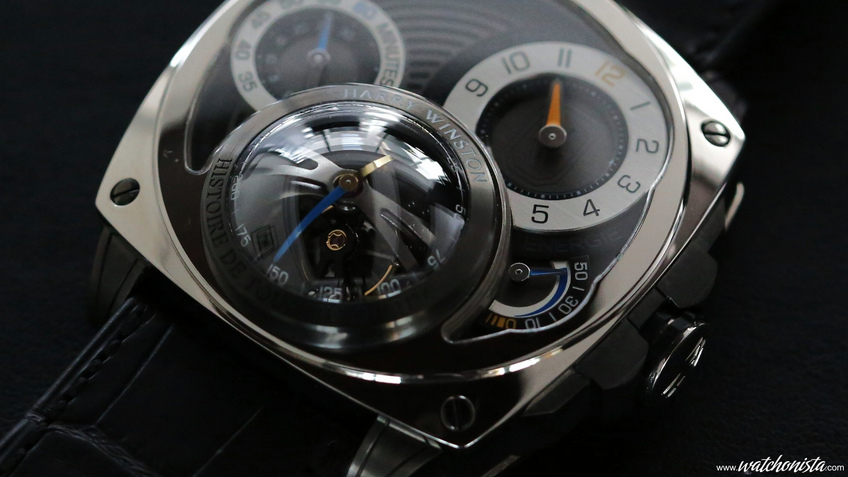
So, to a watch-lover, discovering such a cathedral in avant-premiere is a privilege. Moreover, it is a double-treat as it is undoubtedly the most beautiful of the series. It distinguishes itself from its predecessors by the fact that it can be easily worn and is relatively discreet, if one considers the complexity and the volume of its tourbillon.
The Harry Winston Histoire of Tourbillon saga
- Histoire de Tourbillon 1 featured a double tilted regulating organ using a differential.
- Histoire de Tourbillon 2 was regulated by a bi-axial tourbillon.
Aesthetically as well as technically, Histoire de Tourbillon 4 looks like a direct evolution of these pieces.
- Histoire de Tourbillon 3 featured a totally new complication, a bi-axial tourbillon doubled by a large flat classical tourbillon whose impulses were still combined through a differential.
- Histoire de Tourbillon 4 is still powered by Complitime. This time, they developed a triple-axes tourbillon for with Harry Winston.

As everybody knows, Abraham-Louis Breguet created the tourbillon to compensate the effects of gravity on pocket watches, usually worn vertically or sitting flat on the ground…
In a classic movement, the escapement is fixed, but with a tourbillon it usually completes a revolution around the balance axis every 60 seconds.
The tourbillon accompanied the mechanical watchmaking rebirth in the 80’s. The complication carried prestige because of a tricky tuning process and because of the great technical demonstration it represented; however, a tourbillon was quite useless in a wristwatch, as the wrist very often sits in intermediate positions…
So, in order to get a tourbillon adapted to the movements of the wrist, it needed a device which could adapt to as many axes as the positions of the wrist. So, a tridimensional tourbillon.
Indeed, a triple-axes tourbillon could do the job. It had to be the ultimate solution, where the escapement could move around a sphere instead of a circle.

This layout is more classic than the one used in Histoire de Tourbillon 3. When I write “classic”, it does not mean that it is simpler or less prestigious; it is just less rare. This complication has already been presented by other brands, but using different technical solutions. Of course, one thinks about Jaeger ‘s frenetic bi-axial Gyrotourbillon or about Thomas Prescher’s very slick triple-axes tourbillon.

Histoire de Tourbillon 4 combines the triple-axis of Prescher, with the mechanical complexity and quickness of the Gyrotourbillon!!
The internal carriage completes one revolution in 45s, the intermediate one does the same in 75s and the external one completes a cycle in 300 seconds. Hence, the priority is given to regularity rather than to the multiple positions the escapement can take.
The quest for regularity is also obvious on the double-barrel, which features a slipping spring in order to prevent any overloading.

Therefore, the rotation of the carriages is very smooth. Indeed, the emphasis is put on the multiple off-centered positions of the regulating organ rather than on the rapidity of the revolutions. One witnesses a demonstration of watchmaking mastery rather than a slightly chaotic ballet …
The carriages move smoothly, in an ethereal way.
And it stands in sharp contrast with the totally cyberpunk design!!
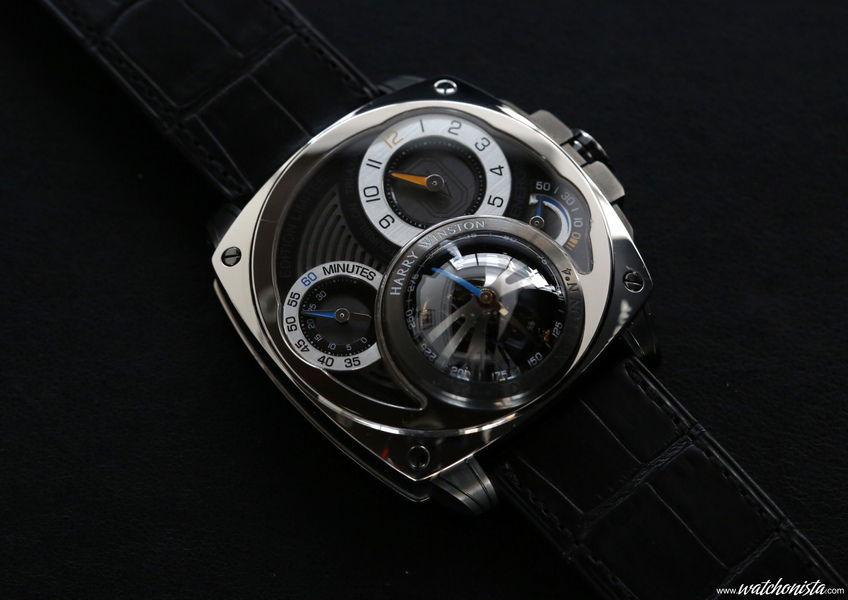
Indeed, if the sub-dials layout is close to that of the Tourbillon 2, the rest is very different, in order to provide the HdT4 with a unique personality; for that matter, as much as in Harry Winston’s history as in the Tourbillon history.
The feature which one notices at first is the domed sapphire above the tourbillon and the cushion case.
Moreover, when worn on the wrist, the watch looks far smaller than the previous HdT and it is not only an impression: it is at least 1.5mm smaller than the older models (47mm vs. at least 48.5mm); it is also the slimmest of the series, it looks even slimmer than the HdT3.

The domed sapphire above the tourbillon is the trick that allowed for a reduction in the volume occupied by the movement.
On the HdT 1&2, the case’s maximum thickness is directly related to the maximum height of the movement. For example, the HdT4’s mechanism is 40.4mm across (about 18 ¼ lignes) by 17.3mm in thickness.
Harry Winston designers chose to let the protruding part (in this case the regulating organ) stick up in order to control the thickness of the watch.
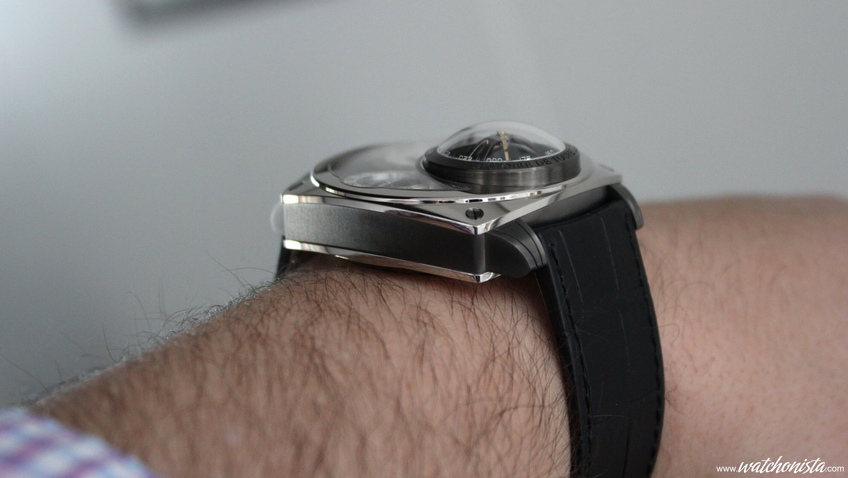
The result of a reduced thickness is a lighter watch: this HdT is very light, about 100 grams only.To achieve this surprising result, an internal and external mass reduction work has been done.
The movement’s plates and bridges are made of titanium, a material twice as light as brass. A more spectacular feature is that the 134 parts of the tourbillon carriages only weigh 1.57 grams.
Harry Winston Histoire de Tourbillon 4 Case and Dial:
Externally, the watchcase uses lots of Zalium (the Zirconium alloy developed by Harry Winston): The case mid-section (darker because of the PVD coating), the lugs, the triple-axes tourbillon’s “bezel” (the external bridges are made of Titanium; the intermediate carriage bridge is made of polished yellow gold) are made of this material. The polished parts and the inside of the case are made of 18K white gold…
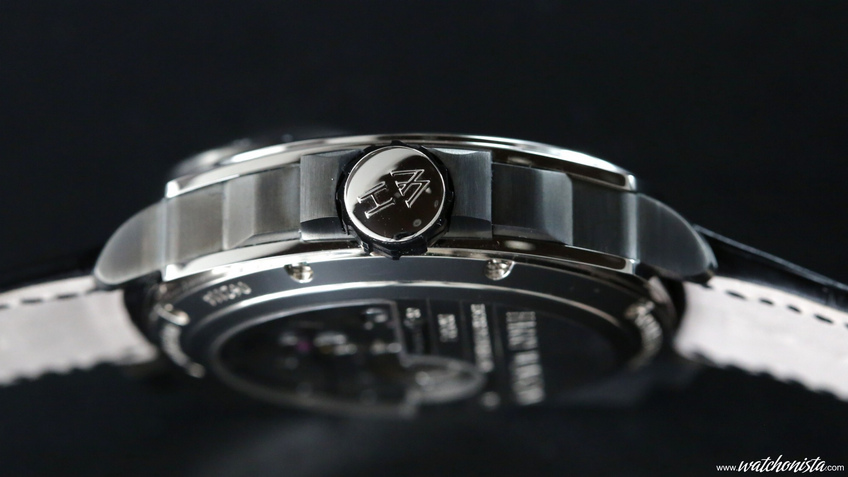
The decrease of the height is featured with the 47mm cushion case with short lugs. As was demonstrated by the brand from Firenze, this design is quite comfortable. A quality further increased by the large bracelet (26mm) and the very flat caseback, which guaranties that the watch will perfectly sit on the wrist. This watch is amazingly comfortable and soft to wear, taking into account to the dimensions and the complication.
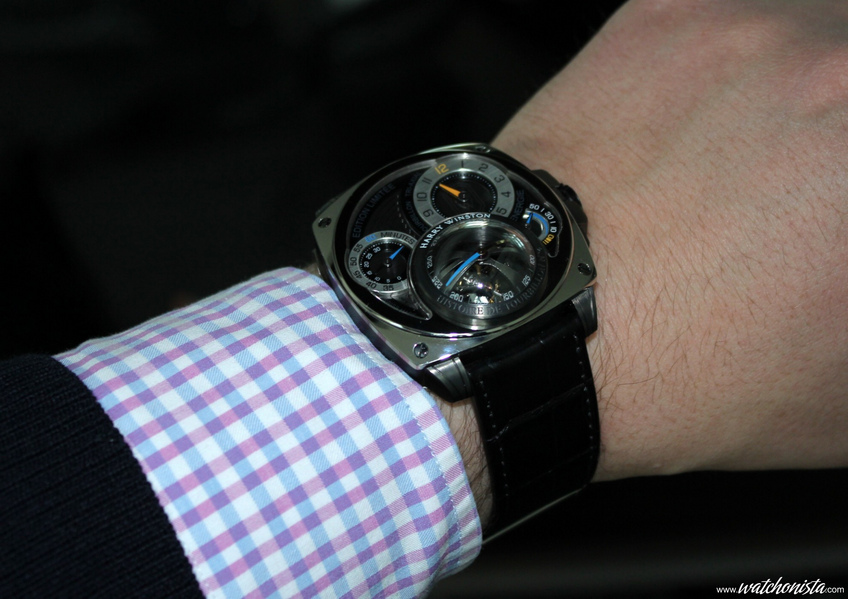
Legibility is good without being exceptional, because the data is displayed on three distinct off-centered counters…
Clockwise, they display: hour, power reserve (50h) and minutes: twice every 30 minutes, the large blue hand takes over the small metallic hand from 31 to 60 minutes.
However, legibility will not be a key point for the lucky future owners, as the revolution carried by the triple-carriage tourbillon is absolutely captivating.
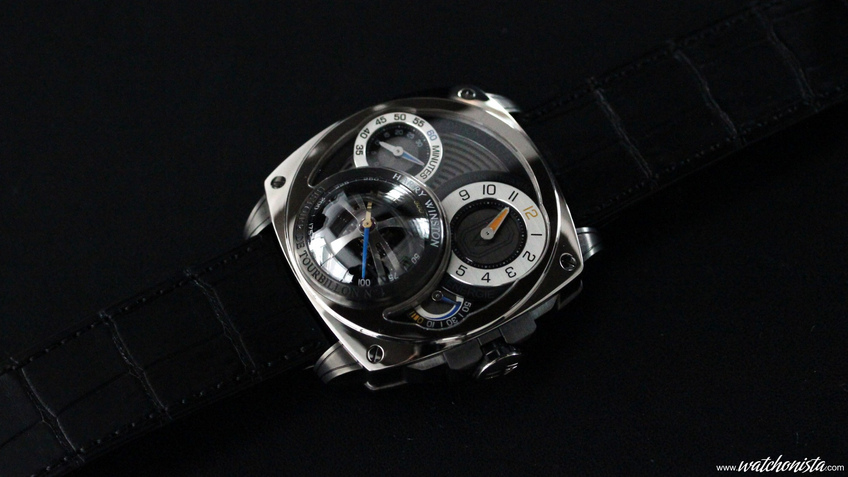
This fourth Histoire de Tourbillon is indisputably the highest achievement of the series. Its design is the most harmonious of all the HdTs, less baroque and sportier than the previous versions without losing its “contemporary art” character, typical of Harry Winston’s New York origins.
Watchmaking-wise, it is a new step for Harry Winston who presents the most complex version ever of a tridimensional escapement device: the triple-axes tourbillon. With this complication, the Histoire de Tourbillon series progressively imposes itself as a tridimensional tourbillons exhaustive catalog…
Harry Winston Histoire de Tourbillon related contents:
- Harry Winston Histoire de Tourbillon 3 review by Watchonista
- Harry Winston Histoire de Tourbillon 1 pictures album
- Harry Winston Official Homepage on Watchonista
- The Opus Official Space on Watchonista
- The technical specifications and description of the Histoire de Tourbillon 4
- Harry Winston Histoire de Tourbillon 4 review by Watchonista






